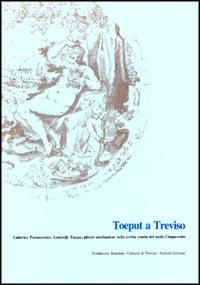
Toeput a Treviso
Ludovico Pozzoserrato, Lodewijk Toeput, pittore neerlandese nella civiltà veneta del tardo Cinquecento
edited by Domenico Luciani and Stefania Mason Rinaldi
Fondazione Benetton Studi Ricerche-Acelum Edizioni
Treviso-Asolo 1988
208 pages
12 illustrations in colour and 212 black and white
cover price 20.65 euros
(Memorie, 1; out of print)
[Toeput in Treviso. Ludovico Pozzoserrato, Lodewijk Toeput, Netherlandish painter in Venetian civilization in the late sixteenth century]
This Flemish painter (his name italianized as Ludovico Pozzoserrato), who arrived in Treviso not by chance in 1582 after an odyssey that had led him from Antwerp to Venice, Florence, Rome and back again to Venice, has never ceased to re-ignite, ever since Carlo Ridolfi (1648), periodic controversies and new investigations. The seminar, the proceeding of which are being presented in this volume, was in fact held more than half a century after the interventions of Peltzer, thirty years after what still remains the only monograph on the painter by Menegazzi, twenty years after the addenda presented by Ballarin, and almost ten years since Pallucchini’s initiatives on Venetian mannerism, culminating in the exhibition From Titian to El Greco, with an intervention “with regard to” Mason Rinaldi.
This time Pozzoserrato’s “return” takes its cue from the arrival in Treviso, on the Foundation’s initiative, of one of his allegorical paintings that is both complex and enigmatic. The Vanity of Wealth or the Melancholic Miser thus enters into dialogue with the autograph works comprised by the prestigious group exhibited in the Museo Bailo. It contributes, with the Monte di Pietà cycle and with the other works in churches or on facades, to turn the March of Treviso into an obligatory port of call for anyone wishing to familiarise himself with Veneto-Flemish mannerism.
The seminar, more than directly discussing Pozzoserrato’s works, contributed especially to the elucidation of his ideas, his sources, his relations with society and the city, his familiarity with treatises and symbological literature, his travels and his rapport with the world of antiquity. And just for this reason, his paintings appeared in a many-sided corpus, expanded, and in part unpublished, beginning with his drawings and including his large canvases from churches, his profane and private works, and his public commissions in fresco.
What emerges from this review is one of those figures who do not impose themselves by striking innovations, but who contribute, nonetheless, with their restless migration from place to place, from manner to manner, to the circulation and forms of contagion that connote the history of culture and art in the Veneto, and who help to weave the history of European culture and art in the late sixteenth century.
Contents
Gaetano Cozzi, Presentazione, 7
Clara Coletti Rosso, Intervento inaugurale, 9
Domenico Luciani, L’operazione Toeput a Treviso, 11
Gino Benzoni, L’ambiente culturale nella Treviso del tardo Cinquecento, 15
Eugenio Manzato, L’ambiente artistico trevigiano del tardo Cinquecento, 25
Giorgio Fossaluzza, Per il Pozzoserrato: opere sacre, 43
Gabriella Delfini Filippi, Toeput si misura con la città: gli affreschi di facciata in Conegliano, 59
Luigi Menegazzi, Grafica del Pozzoserrato, 65
Luciana Crosato Larcher, I piaceri della villa nel Pozzoserrato, 71
Raffaella Morselli, Toeput a Firenze e Roma, 79
Stefania Mason Rinaldi, Variazioni sul tema della “Susanna”, 89
Davide Banzato, Piramo e Tisbe del legato Emo Capodilista: un’aggiunta al Pozzoserrato, 97
Caterina Limentani Virdis, Nota intorno al Pozzoserrato ed altri flandro-veneti, con alcune aggiunte e proposte, 101
Bert Meijer, A proposito della Vanità della ricchezza e di Ludovico Pozzoserrato, 109
Mari Pietrogiovanna, La grafica del Pozzoserrato e i suoi rapporti con Paul Bril, 125
Rossana Buono, Puzzle Vanitatis, 131
Daniel Arasse, L’Allégorie de l’avarice de Pozzoserrato: la proposition de l’image, 135
Charles Hope, La Vanità della ricchezza e la pittura religiosa per dimore private, 145
Francesco Amendolagine, Armida e Tancredi nella Collezione Stuard di Parma e il Theatrum hortis del Pozzoserrato, 151
Eugenio Battisti, Nuove tecnologie per la critica e la memoria dell’arte, 159
Agostino Contò, La cultura nella stampa trevisana di fine Cinquecento, 163
Giovanni Netto, Pozzoserrato “habitante” e “cittadin” di Treviso, 171
Denny D. Van Dongen, Toeput e Beuckelaer, 175
Repertorio dei testi manoscritti e a stampa menzionati nel volume, 177
Indice delle illustrazioni e repertorio fotografico, 193
Indice dei nomi e dei luoghi, 201
